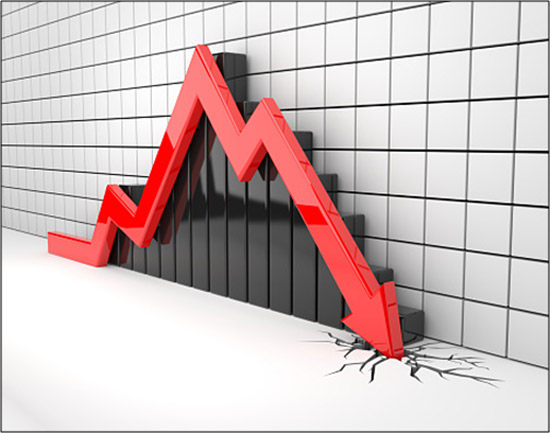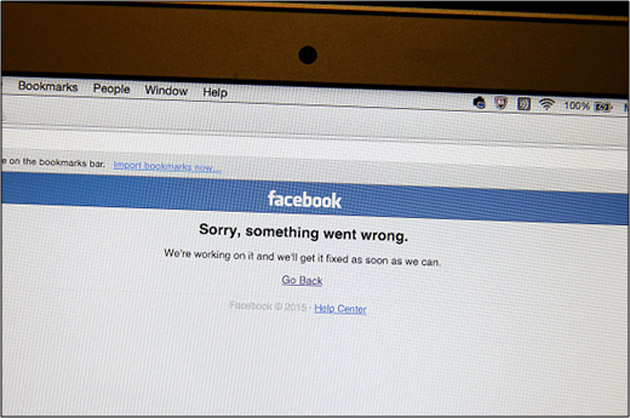| -- | April 3, 2018 Three Cracks Threatening Stocks By Patrick Watson You may have noticed stocks have stopped going straight up. By itself, that’s not scary. Bull markets and high volatility can coexist, and often did until the last few years. No, the scary part is that bull markets fall apart slowly. | If you're fed up with ads, you should click this one. Jared Dillian has an important message for you. READ IT HERE |
Smaller cracks accumulate to set up the big breaks. History shows 2008 was a terrible year—but the Dow had peaked months earlier, in October 2007. Even in 2008, the bull took a long time to collapse. The Bear Stearns collapse in March was even followed by a nice rally because people thought the worst was over. But six months later Lehman went bankrupt, and then it was six more months before the final bottom in March 2009. So, like the metaphorical frog in boiling water, you can be in the middle of a bull market’s unraveling and not even know it—or at least not know how bad it will get or when it will end. That should worry you because right now, the number of cracks is growing while the ability to patch them up is not. Let’s look at just three of those cracks. 
Photo: Getty Images Crack #1: Cryptocurrencies Last fall, investors went crazy for crypto, mainly Bitcoin. Prices climbed fast as “fear of missing out” caused near-panic buying in some quarters. Panic buying is almost always a mistake, and sure enough, bitcoin fell from its peak of $19,000 in December to below $7,000 today. Bitcoin fans are undeterred and convinced it will be back. Maybe so. But the more immediate effect is that crypto-mania soaked up a lot of uninformed risk capital that is now less able—and probably less willing—to take the risk of buying stocks. This is important because according to Dow Theory, “distribution” is the first phase of a primary downtrend. That’s when the last buyers enter the market, buying stocks from big sellers who perceive signs of trouble. It gets worse from there… eventually a lot worse. In this case, the distribution phase could already be near its end if those last few buyers already spent (and often lost) their cash on other, non-equity assets like cryptocurrencies. 
Photo: Getty Images Crack #2: Bond Yields We entered 2018 knowing the Fed would both raise interest rates and reduce its bond portfolio. Those two factors might have been manageable, but others soon followed. The tax cuts Congress passed in December, combined with subsequent spending bills, are driving up the federal budget deficit faster than most expected. That’s forcing the US Treasury to sell more bonds, which puts even more upward pressure on bond yields… while the Fed is already tightening. Higher bond yields, in turn, make stock dividends a less attractive income source. At the end of March, the S&P 500 dividend yield was 1.85% and the one-year Treasury yield was 2.08%. Yes, stocks have capital gains potential and T-bills don’t. But the bull market is nine years old now. It could continue—but it could also reverse, handing you capital losses as well as subpar yield. To choose stocks now, you must accept lower income in exchange for higher principal risk. A growing number of buyers don’t like that deal. The stock market doesn’t need aggressive selling to make prices fall. Reduced buying interest could do the same thing. 
Photo: Getty Images Crack #3: Tech Trouble Every bull market has leaders. This one has depended heavily on a handful of giant technology stocks, namely Apple (AAPL), Amazon (AMZN), Facebook (FB) and Google’s parent company Alphabet (GOOGL). All these are having problems. Apple’s expensive new iPhone X didn’t sell as well as expected, and Google Chromebooks are capturing its once-dominant position in schools and colleges. Amazon is getting attacked by none other than the President of the United States himself, who says it is hurting small retailers and taking unfair advantage of the US Postal Service. Old-fashioned retailers are fighting back too. Facebook’s success in gathering personal data to use for advertising has thrown the company’s whole business model into question. Regulators and lawyers are circling like vultures. Google’s ad sales and data collection are also getting some negative attention, as is its near-monopoly position in many markets. Investors are starting to question the future. These companies will likely survive and remain profitable. But their currently handsome profit margins probably won’t, and it’s already showing in their stock prices. That’s problematic for a bull market built on their once-reliable growth. 
Photo: Getty Images What to Do Those three cracks, plus others I haven’t mentioned, don’t necessarily mean a crash is imminent. We can’t even rule out a renewed uptrend—stranger things have happened. For one, first-quarter earnings reports will probably look pretty good, but the tax cuts are funding share buybacks and debt reduction rather than pay raises and capital investments. In other words, companies are effectively - eating dessert first while
- avoiding their vegetables.
That’s fun for a while, but eventually makes you sick. So I still think the risk of further losses outweighs the risk of missing further gains. A cracked vase doesn’t spontaneously heal itself. The cracks get worse with time, not better. In the last bear market, the ideal strategy would have been to either exit near the late-2007 peak or hold on through the whole storm. Few investors did either of those. Instead, they waited and then sold at lower prices. That wasn’t the intent, but it is what happened. If you believe the top is in, now is the time to act. At the very least, start looking for opportunities to take profits and reduce exposure. Do it on your own terms, not the terms the market gives you. You’ll be glad you did. See you at the top,  Patrick Watson P.S. If you’re reading this because someone shared it with you, click here to get your own free Connecting the Dots subscription. You can also follow me on Twitter: @PatrickW.  | Subscribe to Connecting the Dots—and Get a Glimpse of the Future
We live in an era of rapid change… and only those who see and understand the shifting market, economic, and political trends can make wise investment decisions. Macroeconomic forecaster Patrick Watson spots the trends and spells what they mean every week in the free e-letter, Connecting the Dots. Subscribe now for his seasoned insight into the surprising forces driving global markets. |
 Senior Economic Analyst Patrick Watson is a master in connecting the dots and finding out where budding trends are leading. Patrick is the editor of Mauldin Economics’ high-yield income letter, Yield Shark, and co-editor of the premium alert service, Macro Growth & Income Alert. You can also follow him on Twitter (@PatrickW) to see his commentary on current events. Senior Economic Analyst Patrick Watson is a master in connecting the dots and finding out where budding trends are leading. Patrick is the editor of Mauldin Economics’ high-yield income letter, Yield Shark, and co-editor of the premium alert service, Macro Growth & Income Alert. You can also follow him on Twitter (@PatrickW) to see his commentary on current events.
Share Your Thoughts on This Article

Use of this content, the Mauldin Economics website, and related sites and applications is provided under the Mauldin Economics Terms & Conditions of Use. Unauthorized Disclosure Prohibited The information provided in this publication is private, privileged, and confidential information, licensed for your sole individual use as a subscriber. Mauldin Economics reserves all rights to the content of this publication and related materials. Forwarding, copying, disseminating, or distributing this report in whole or in part, including substantial quotation of any portion the publication or any release of specific investment recommendations, is strictly prohibited.
Participation in such activity is grounds for immediate termination of all subscriptions of registered subscribers deemed to be involved at Mauldin Economics’ sole discretion, may violate the copyright laws of the United States, and may subject the violator to legal prosecution. Mauldin Economics reserves the right to monitor the use of this publication without disclosure by any electronic means it deems necessary and may change those means without notice at any time. If you have received this publication and are not the intended subscriber, please contact service@mauldineconomics.com. Disclaimers The Mauldin Economics website, Yield Shark, Thoughts from the Frontline, Patrick Cox’s Tech Digest, Outside the Box, Over My Shoulder, World Money Analyst, Street Freak, ETF 20/20, Just One Trade, Transformational Technology Alert, Rational Bear, The 10th Man, Connecting the Dots, This Week in Geopolitics, Stray Reflections, and Conversations are published by Mauldin Economics, LLC. Information contained in such publications is obtained from sources believed to be reliable, but its accuracy cannot be guaranteed. The information contained in such publications is not intended to constitute individual investment advice and is not designed to meet your personal financial situation. The opinions expressed in such publications are those of the publisher and are subject to change without notice. The information in such publications may become outdated and there is no obligation to update any such information. You are advised to discuss with your financial advisers your investment options and whether any investment is suitable for your specific needs prior to making any investments.
John Mauldin, Mauldin Economics, LLC and other entities in which he has an interest, employees, officers, family, and associates may from time to time have positions in the securities or commodities covered in these publications or web site. Corporate policies are in effect that attempt to avoid potential conflicts of interest and resolve conflicts of interest that do arise in a timely fashion.
Mauldin Economics, LLC reserves the right to cancel any subscription at any time, and if it does so it will promptly refund to the subscriber the amount of the subscription payment previously received relating to the remaining subscription period. Cancellation of a subscription may result from any unauthorized use or reproduction or rebroadcast of any Mauldin Economics publication or website, any infringement or misappropriation of Mauldin Economics, LLC’s proprietary rights, or any other reason determined in the sole discretion of Mauldin Economics, LLC. Affiliate Notice Mauldin Economics has affiliate agreements in place that may include fee sharing. If you have a website or newsletter and would like to be considered for inclusion in the Mauldin Economics affiliate program, please go to http://affiliates.ggcpublishing.com/. Likewise, from time to time Mauldin Economics may engage in affiliate programs offered by other companies, though corporate policy firmly dictates that such agreements will have no influence on any product or service recommendations, nor alter the pricing that would otherwise be available in absence of such an agreement. As always, it is important that you do your own due diligence before transacting any business with any firm, for any product or service. © Copyright 2018 Mauldin Economics | -- |
